Lily Jansz and John Bruha – Pioneering Team
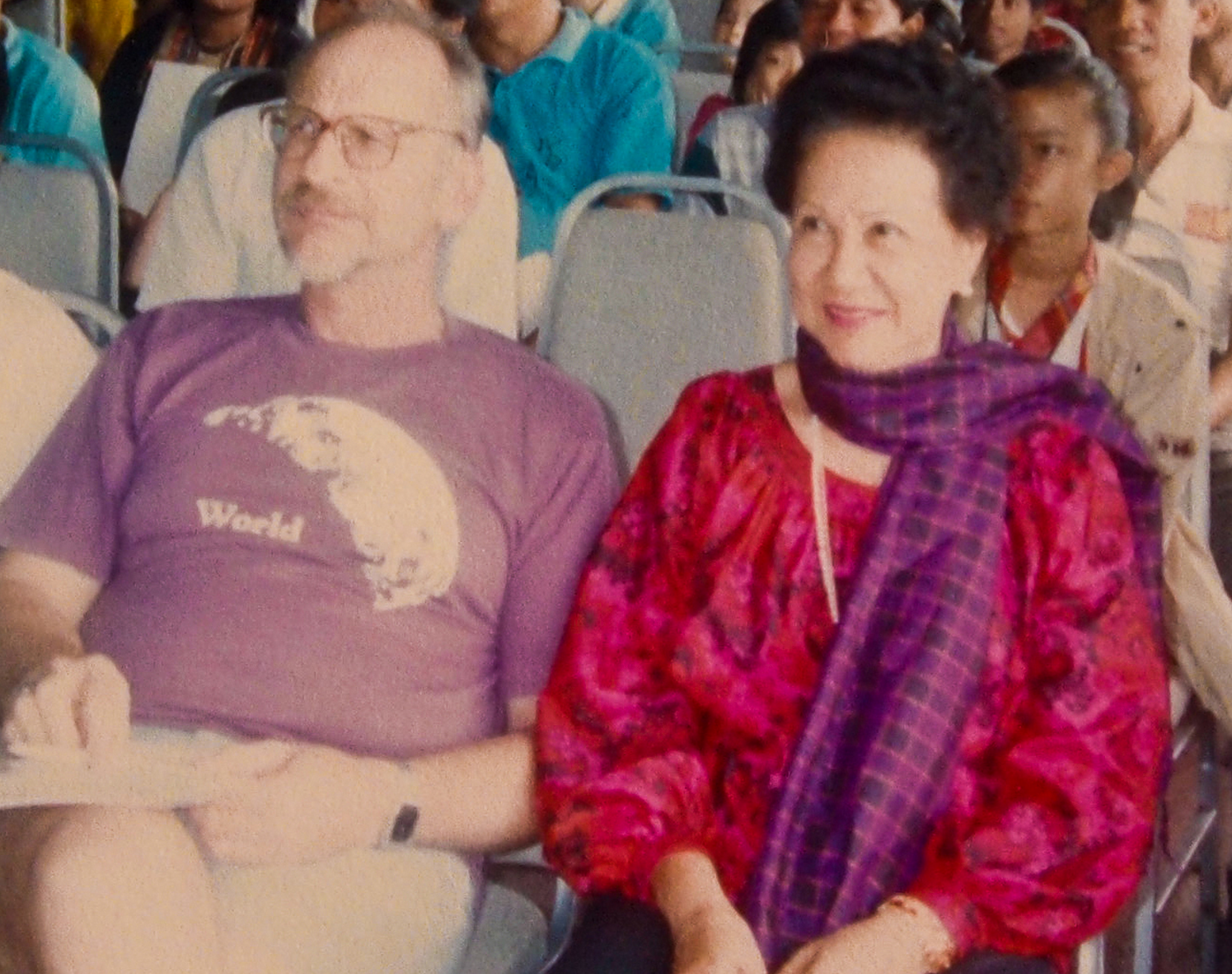
Dr. John Bruha-Australia
Well before we met, we had each been pioneering for the Cause of Bahá’u’lláh. For almost ten years, Lily had been sharing her time between teaching in the Faith in Penang and pioneering in South Thailand.
On 19 September 1989, in response to a call for for pioneers from Australia to Malaysia, I had arrived in Kota Kinabalu, Sabah. With the assistance of the Bahá’í Teaching and Administrative Committee of Sabah and individual Bahá’ís, I was able to start a desktop publishing company which was also to be training scheme for young Bahá’ís from Sabah and Sarawak.This venture failed; but was soon replaced by a challenging position with Kinabalu Commercial College.
Lily and I had had an unmemorable 30-second introduction at the 1988 Port Dickson Winter School.
Our first memorable meeting was characteristic of the way our life together unfolded. During the Christmas holiday of 1990, I took a short break from pioneering in Sabah to attend the wedding of my step-daughter in Canberra, Australia. Visiting Bahá’í friends still left several days before my flight back to Sabah. Canberra Bahá’ís suggested that I spend the time in Cabramatta, a Sydney suburb where a teaching campaign was taking place amongst Vietnamese migrants.
It was a hot summer afternoon when I got off the train and walked to the house that was being used as the Centre. As I approached the door, a lovely lady quietly offered me a cold drink. We introduced ourselves and began small talk about pioneering. It turned out that she was Lily Jansz, a Malaysian pioneer to Thailand and former pioneer to Sabah.
Lily’s daughter, Chong Siew Lian, had given her mother an air ticket to go to Sydney during Christmas 1990. Lily had been advised to go to Cabramatta to help with a Vietnamese teaching project. The teachers were staying at a rented house for the project. Lily had offered her assistance in cooking for the teachers.
Thus, on a hot summer afternoon in Sydney, Australia, we had a cool drink, relaxed in the shade and conversed about we were each doing and the importance of service in our lives. As the day began to cool, we went together to the markets to get materials for the evening meal. We then cooked for the youth, who were ravenous from an afternoon’s teaching. Everyone had a short rest before the evening’s fireside. After, we served supper and then all slept.
Next morning we sent the team out with a good breakfast. After washing up, we had a hot drink, continued to become acquainted and further discussed service in our respective lives. At about 10:30, one of us (neither could remember who) said, “Why don’t we get married and pioneer together. It won’t be so lonely”. Short consultation resulted in agreement and we began detailed planning.
First thing, we began fulfilling Baha’i requirements and logistical planning. By telephone and during several meetings in Singapore, as three of our parents were deceased; we set out to obtain the permission of our children and make family acquaintance. All preparations were completed; so our wedding was scheduled for the Kota Kinabalu Baha’i Center on 12 August 1991.
In addition to guests from Sabah, Singapore and Malaysia; it happened that my eldest son, Matthew, on the return leg of a round-the-world trip was able to attend. For a wedding trip, we went to Ranau to speak at a fireside and visit local believers and home-front pioneers.
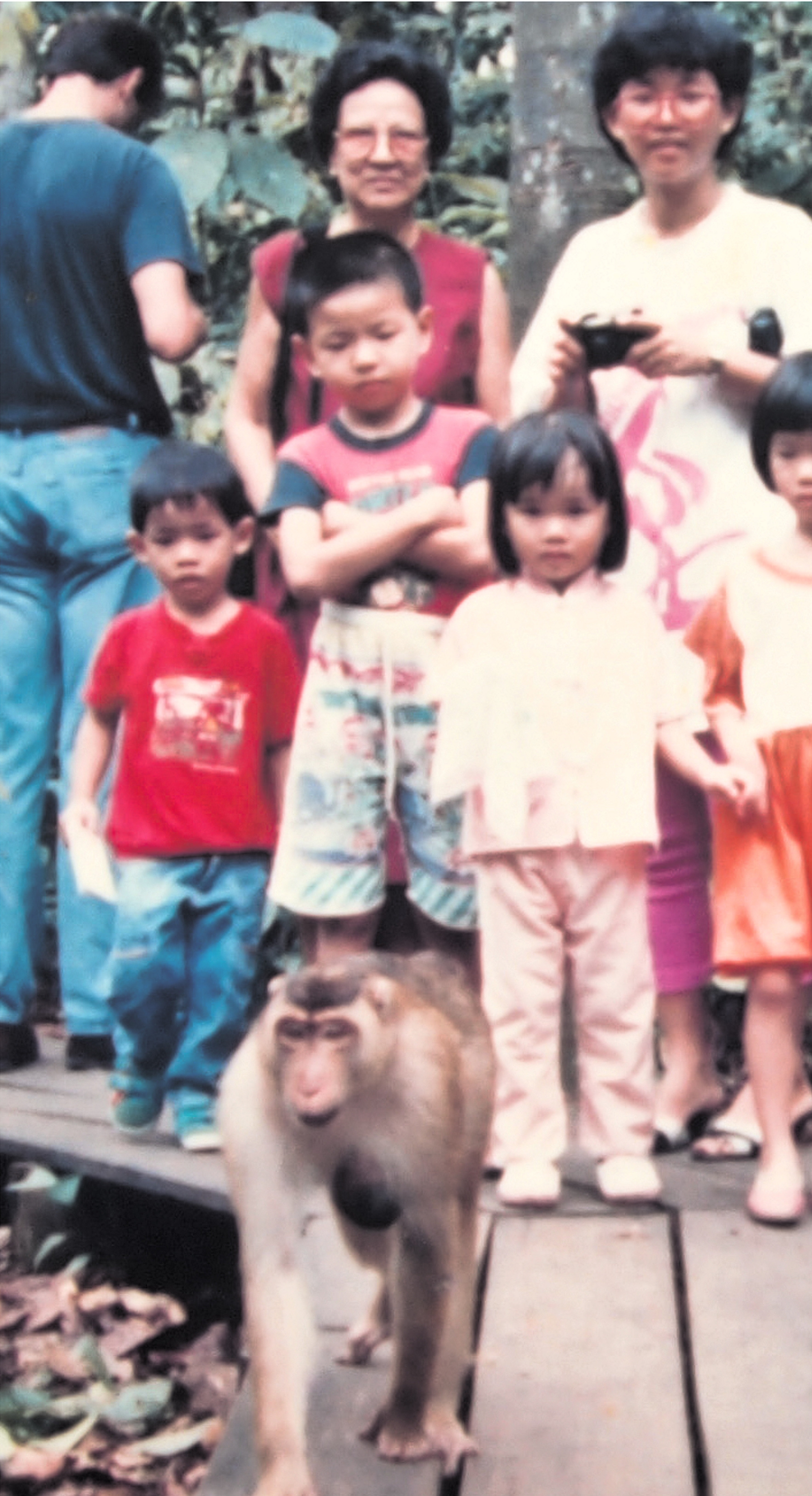
With Children in Sepilok on a teaching trip to the East Coast
On returning to Kota Kinabalu we took a house in Taman Jumbo. It was large enough to serve as a Baha’i Centre for the Putatan Community. There were two bedrooms for two Iban youth pioneers from Sarawak.
The large hall was an excellent venue for Feasts, Holy Days, Assembly meetings and other functions. Lily made sure that there was enough food for anyone entering the door.
She became the “mind and spirit” and I became the “hands” of our family. Shortly, a by-election added her to the Local Spiritual Assembly. I worked at Kinabalu College five days a week while she made us a home and did 2-3 daily teaching trips. Weekends saw two- and three-day teaching trips to the interior.
Our family consultations, for a period, centred on our funding of family teaching activities. In Taman Jumbo and later in Kampung Tuunon, went to the beach and gathered small shells. Daytime, Lily cleaned hundreds. We then sized and graded them in the evening.
Thereafter, we bought settings and made shell-based ear-rings and brooches. Lily sold them to Bahá’ís and neighbours. and the receipts went to the Local Fund, earmarked for teaching.
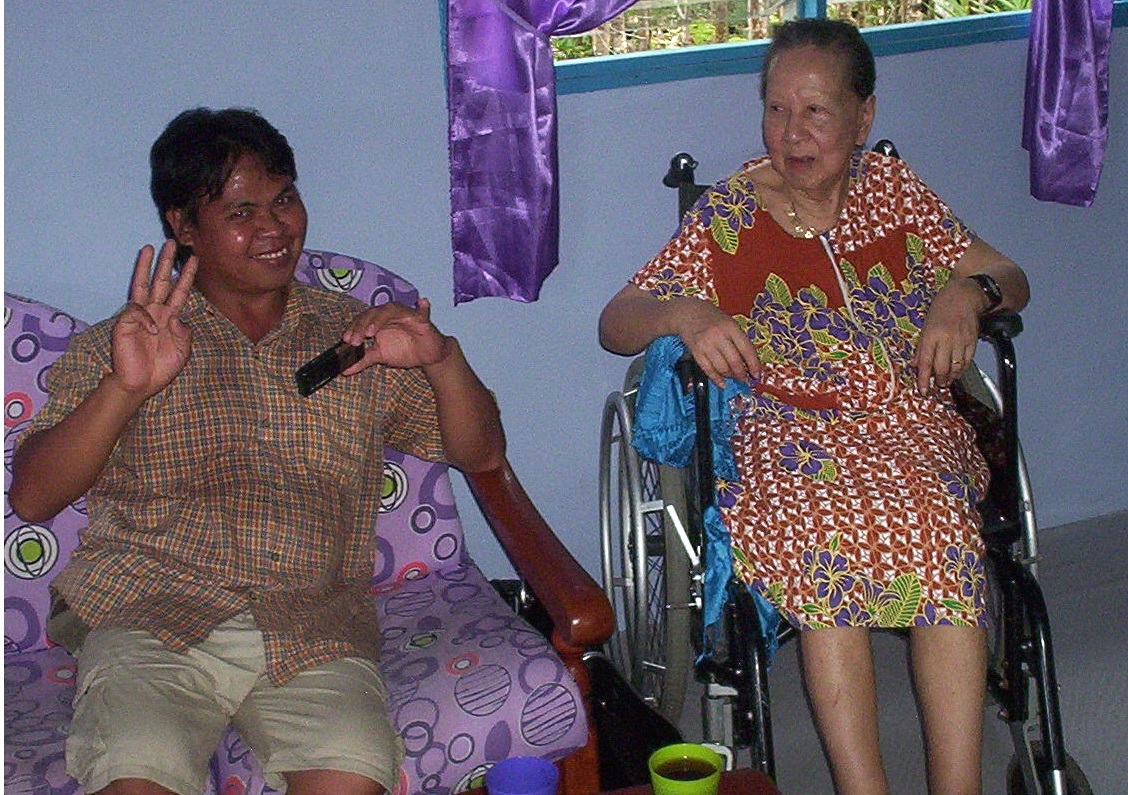
Friends after Teaching in Kampung Bangkau- Bangkau, Pitas
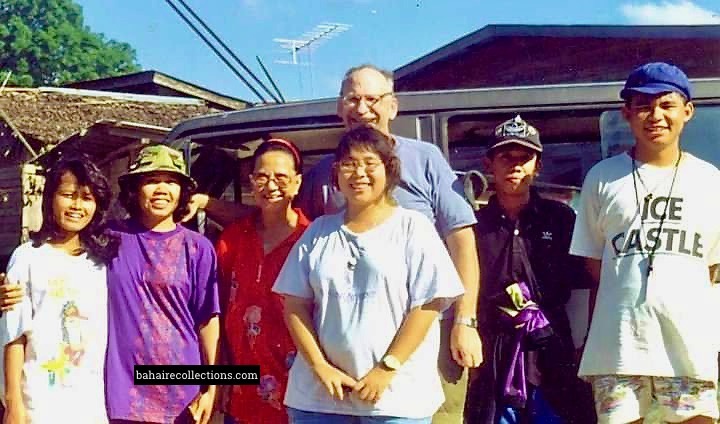
Gathering in Pitas in 1993 L-R: Chusna, Betty, Lily Jansz, Dr. John at back, Chang Ruiz (now in USA), Riban and Ryan.
Within two years the number of adults in Putatan rose to 14. Lily was no longer a member of the Assembly.
After a couple months, she suggested to me that since the Assembly was numerically safe; we should pioneer to a nearby village. We consulted about such a move and then consulted with the Assembly for its permission. This granted: we made the move.
Many kampongs were evaluated as suitable localities for the relocation. Kampong Tuunon in the Penampang District was thus opened to the Faith. We stayed there as members of the community, introducing the villagers to Baha’is and the Faith. Our home became a stopping point for Baha’i Kota Kinabalu and Putatan Bahá’ís driving into the interior for teaching or on their return for a cool drink, a light meal, a rest or even a shower. During this period, Lily made frequent trips to Penang and Thailand to keep up with her teaching and pioneering work there.
On next door neighbour, who worked at the road-sign department made a sign for the kampong, “Kg Ridván”
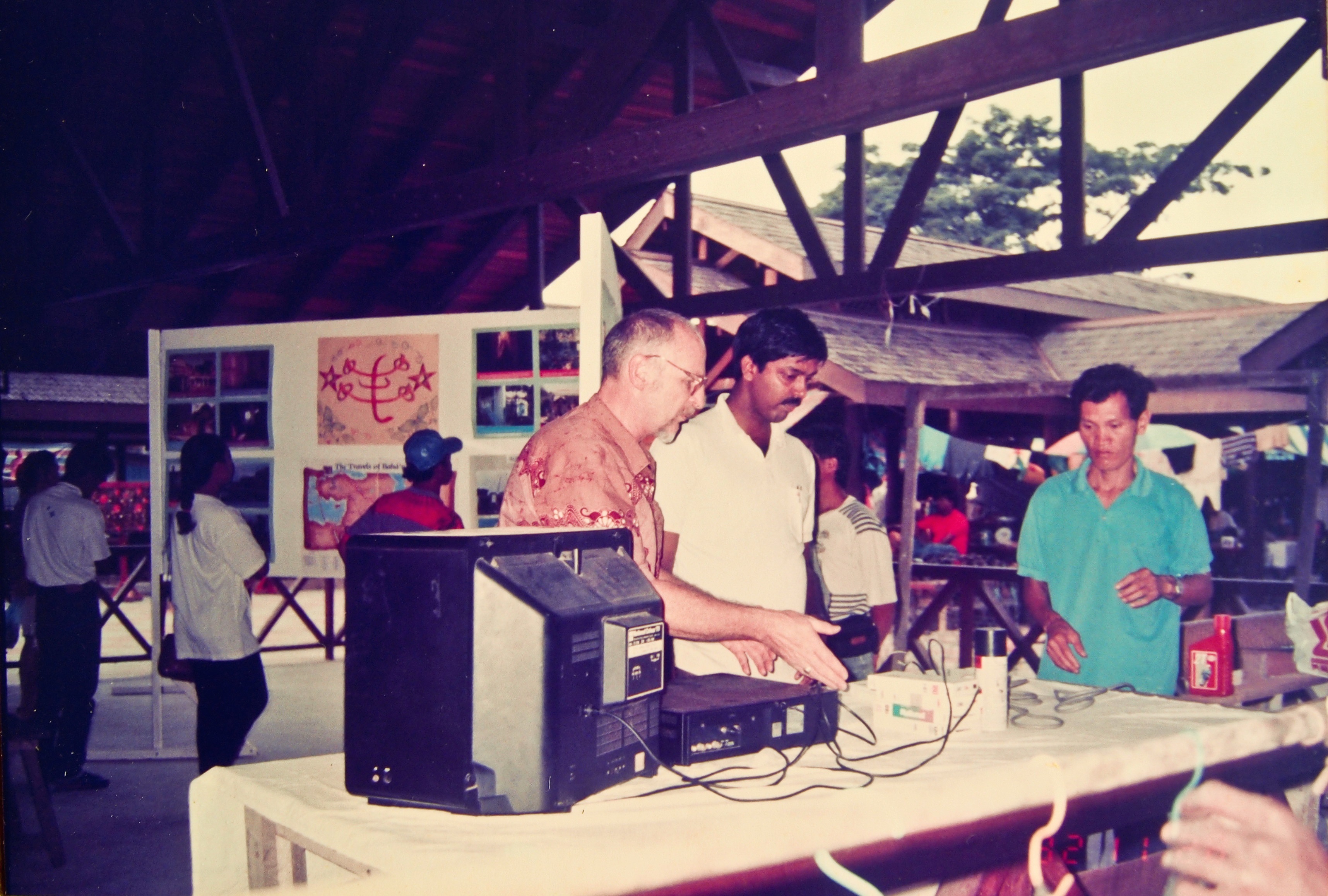
Penampang Teaching Exhibit
During 1992, we each had many blessings. The first was contained in a phone call from my brother in Wisconsin. Since 1975, he had been reading/studying anything he could find on the Faith. By 1991, he had recourse to the library of the University of Wisconsin, 30 miles away. One snowy winter’s day he had gone to find cross-references for the meteor showers of 1844 as mentioned in God Loves Laughter. Finding none, he drove home wondering what to do next. In his letter box, he found the latest issue of American Heritage, a major history magazine. Going into the house, he found that the cover story was about the meteor showers. Phoning us the next day he said, “Bahá’u’lláh has been playing ticks tricks on me. I declared last evening.”
Secondly; because I could’t take time off in Sabah, it was arranged that my brother would facilitate Lily’s transit rest and transit assistance for her attendance at the World Congress in New York. On her return, Lily talked little about the Congress; her strongest impressions were those surrounding poverty, hunger and homelessness that she saw in New York City. Our considerations for quite a while centered around what and how the Faith could do about these problems. Our deliberations repeatedly settled on the need for more and more focused teaching. Ideas would become actions both in community and personal efforts.
Lastly, on the occasion of the Centenary of the Ascension of Bahá’u’lláh, only those on foreign passports could be members of Malaysia’s nineteen representatives. Fortunately, I was one of these and managed to visit the Sacred Shrines as part of the Celebrations. An extended return trip allowed me to visit Linz, Austria, and several cities in the Czech Republic; where I had the good fortune to participate in firesides. This part of the trip culminated in my visiting the farm from which my grandfather, at age 12, migrated to the USA a century before.
On our return from these trips, we settled down in kg. Tuunon with regular, weekend deepening visits to the Pitas district, which had been opened to the Faith in 1991.
In late 1994, the World Centre asked me to coordinate the BIC-Hanoi English Teaching Project in Vietnam. While I went to KL to start organizing the project, Lily liquidated our Sabah things, car and all, and went back to Penang to resume her Penang and Thailand teaching while waiting for her Vietnam visa. This is the only time, Lily ever showed impatience. According to the agreement, all visa applications were to go through the Baha’i International Community. Friends in Malaysia, seeing her tried to get Lily to apply for a visa on her own behalf. Two visa applications from the same person gave the Vietnamese government an opportunity to slow down the process.
Five or six days a week, I rode my bicycle around Hanoi, followed by my secret police escort, to meet small groups in schools for exercises in conversational English. Average days ran from eight in the morning until seven in the evening. Between classes in schools, I worked with small groups in offices and in homes of “high government officials”.
Occasionally, groups of students would take me to restaurants for supper. Other times, they would take me to see the countryside and points of interest. One afternoon, we visited a nearby Buddhist temple and I had an extended discussion of the teachings of Buddhism with the monks. During the time that the monasteries had been closed, much learning was lost.
Lily’s visa did not materialize and after 7 months the authorities in Hanoi “strongly suggested” that I return to Malaysia. When I debarked the plane in Penang, I walked right past Lily, not being recognized by her; I had lost so much weight in Hanoi. Lily nursed me back to a reasonable health and weight.
Our next problem was where to go next. Several months were spent in applying for work and a new pioneering post all over Southeast Asia and even into Europe and the Middle East. Lily suggested scores of leads in Asia only to find that all doors in Asia were closed. Over 200 applications, round the world, resulted in no place to go.
Our next idea was that we move to California and look for work; while living with my son, Mick. He and his cat had a 5 bedroom house on the vineyard he was managing. Thus, we became members of the Baha’i Community of Eldorado County Northeast. It wasn’t long before we became members of the local Assembly. As usual, Lily took it upon herself to be the task force looking after isolated members of the community and of provision of food for gatherings including unit conventions. Monthly, our van regularly took needy members of the community to free food stalls.
Part of the winery was a walnut orchard. The first autumn’s crop was not big enough to make a harvest profitable. One morning, Lily suggested that we take a walk into the orchard. There, she pointed out the wasted walnuts lying on the ground. Gently she led my thinking along a track of making them available for the Baha’i community. We harvested the fallen and easily dislodged nuts (3 Lily-sized sacks full). While I continued to look for work and to develop Baha’i teaching materials, she sat outside on the veranda in the cold and shelled the nuts. When finished, she offered the nuts to members of the community in exchange for contributions to the Fund. By this time we had become members of the local Assembly. This was during the “emblazon His Name” phase of the current Plan.
The local Assembly decided that the community should have a consistent presence at the local “Flea Market.” We reserved a stall, developed displays and literature introducing the Faith and mobilized at 0400 on Sunday mornings. As time went on, we found “pretties” at garage sales and added them to the stall to attract attention. I also found part-time work in teaching university extension classes and consulting in school facilities design.
In 1997, I was appointed to the Publishing Trust of the National Assembly of the USA. This year called for two trips to Chicago. On these trips I managed to meet with my brother David, in Hebron, in rural Wisconsin. He was working as a teacher, running a flea-market stall, and living on a farm.
By the winter of 1997-8, employment opportunities in California had dried up. After consulting with him about employment and the situation of the Faith in his area, we decided to live with him and try to help organize local teaching efforts.
There were 14 Baha’is in the county where he lived. Because they were scattered over several localities stretching along the Rock River, they were unable to form registered group, and were unable to form an Assembly. Somehow there had to find a way to formally organize for teaching. Lily, Dave and I consulted and decided, that we would move to Wisconsin and I look for work and help with organization of Bahá’í teaching efforts.
A barbecue/meeting was held to consult on getting recognized by the National Office. Several factors came together to make it possible to gain recognition. One, all the localities were situated along the Rock River Valley. Two, if there were a formally established teaching committee in the community, it would be recognized by the National Office and would get all of the documents that were sent out to Assemblies and Registered Groups. Thus was formed the Rock River Valley Teaching Committee.
As this solution started to work, the job market in the area dried up. Lily and I needed another place to go.”Where do we pioneer next”? While driving 2000 miles back to California, this and related questions were the focus of our consultation. By the end of the trip, the answer to the questions was, “Australia”. Thus, because we were members of the United States Bahá’í Community, we became pioneers from the USA to Australia.
From California we flew to Penang in July 1998. While Lily stayed there, I flew to Canberra to make her visa arrangements, and to get housing and employment. Some eight months were spent in getting permanent residence in Australia for Lily, and a disability pension for me. While waiting in Penang, Lily made regular teaching trips to Thailand and Penang and taught children’s classes that had been started decades previously.
In Canberra, the Australian Capitol Territory (ACT) Baha’i community had just taken possession of its newly completed Bahá’í Centre. I was offered the position of caretaker for this property. About 2,400 seedlings for native trees and shrubs had been planted and needed to be watered to keep them from dying in the very hot, dry summer. Other residents on the property were around 40 kangaroos.
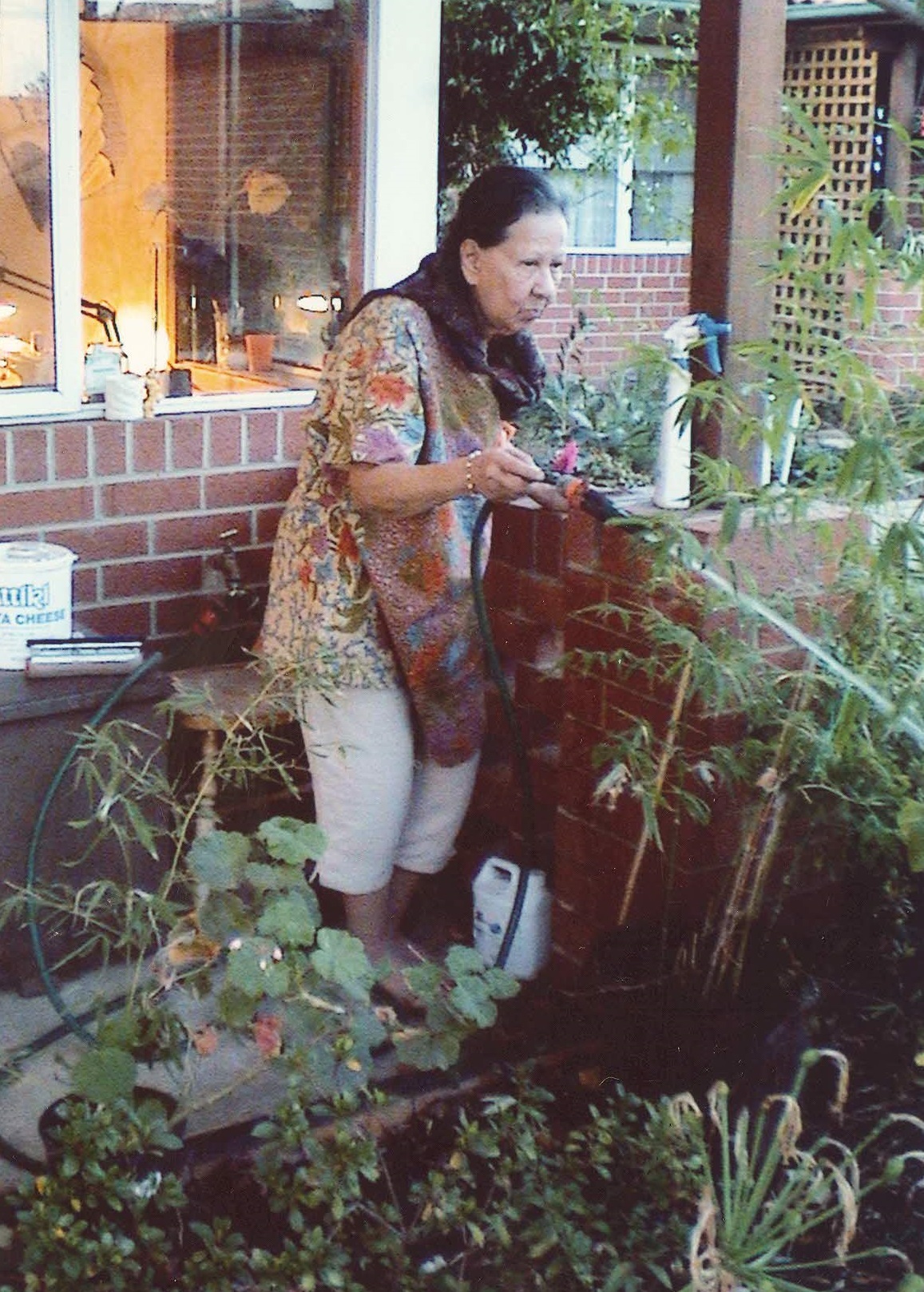
Lily watering the plants we sold at our Teaching Stall in Canberra
After Lily arrived, we found that living in the Baha’i Centre did not let us be effective, teaching, members of the community. To overcome this, we moved in with my son, Matthew. Living there, I was able to work five mornings a week delivering 300 newspapers a day. My pay allowed us to buy a box trailer, a frame and canopy, and display tables as well as a computer and printer, software and printing stock to make a “class” stall.
Most current teaching in the community targeted professional people. Now, we felt that we should bring the Faith to the notice of a different segment of society. Our previous experience in teaching had concentrated on lower strata of society. Thus, we chose a way to engage the buying and selling sector. To do this, we initiated and manned a weekly teaching stall at the local flea market in Canberra. We consulted with my brother for advice and decided to add pretty items to attract people’s attention. While she was able, we would spend every Saturday morning going to garage sales to buy “lures”. These not only attracted seekers to the material “treasures”, they also brought a weekly profit of approximately A$55.00 that went to the National Fund. This allowed the stall to operate without Assembly funding for 11 years.
Statistics kept on the stall show that it was opened on 254 occasions over 11 years. I designed over 200 bookmarks, compilations containing quotations from the Holy Writings, pamphlets and refrigerator magnets of which we gave away over 22,000 pieces to more than 22,000 people who stopped to look at the sale items and the Baha’i materials. Lily was most of the time at home but when well she would often come with me in her wheel chair.
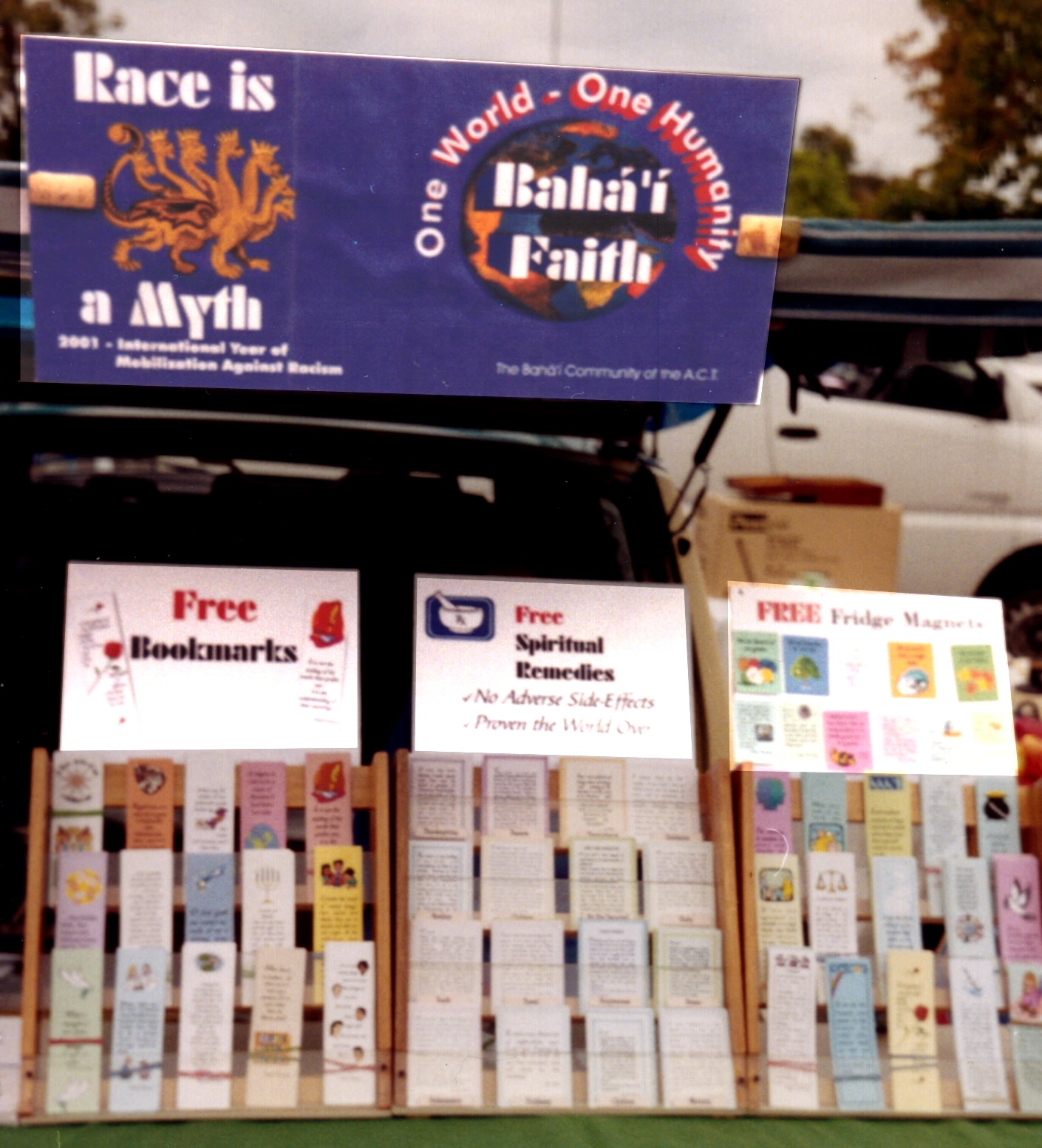
Literature Section of the Stall at the Flea Market
By Autumn 2011, we had served in this low cost, but effective way for twelve years. Both of us had declined in health and then, in July 2012, a serious mishap brought us to a screeching halt. I passed out while driving home from shopping. This caused us to roll over a parked car and settle hanging up a tree.
My attempts at holding the van steady damaged every joint in my back, including the fractured sternum and 4 fractured ribs. Lily seriously bruised the same assortment of bones.
Our conditions declined so that we could no longer stay at home without full-time care. A rest home on the New South Wales South Coast accepted us as residents. Initially, we were put into separate rooms. However, the last six months of 2015 brought a rapid decline in Lily’s health. Towards the end of December, Lily started to lose her appetite, mostly because she needed more and more help with eating. The evening of January 9th, she quietly grasped my arm, told me she really loved me and that our happiest times were together in Sabah
At 6 o’clock on 10 January 2016, she woke up, chatted gently to me. At 8 o’clock she awoke and asked to be taken to the palliative care room. At noon, Lily’s soul ascended to the realms in the Supreme Heights

Lily Jansz and Dr. John Bruha
Messages on Her Passing
Several messages were sent on the passing of Lily. The Spiritual Assembly of the Bahá’ís of Malaysia in its message to the community in Malaysia dated 12 January 2016 referred to her as a devoted and faithful maidservant of the Blessed Beauty and recalled with much gratitude her praiseworthy contributions to the advancement of the Faith in the early years in Penang, as well as her pioneering services in Thailand and Sabah. Similar condolences messages were received from the National Spiritual Assemblies of Australia, Sabah and the USA, in which accolades were placed upon her steadfastness and services for the Faith.
The National Spiritual Assembly of the Bahais of Sabah in its letter dated 12 January 2016 informed that special prayers were offered for her and ended with this sentence, “On this earthly plane, we will always be encouraged and inspired by her radiant spirit and legacy”.
The National Spiritual Assembly of the Bahais of USA in its letter dated 20 January 2016 assured prayers at the Bahai House of Worship in Wilmette.
The National Spiritual Assembly of the Bahais of Australia in its letter dated 27 January 2016 assured prayers for her at its next meeting over that weekend.
The Universal House of Justice in its letter dated 13 January 2016 sent this message to the National Spiritual Assembly of the Bahá’ís of Australia, “ The Universal House of Justice was saddened to learn from your email letter dated 12 January 2016 (13 Sharaf 172) of the passing of Lily Jansz, dedicated handmaiden of Bahá’u’lláh. May the memories of her devoted services to the Faith—particularly in carrying, together with her husband, Dr. John Bruha, the light of Divine Guidance to Malaysia and other lands—be a source of inspiration to all those who knew her. Kindly extend the loving sympathy of the House of Justice to her husband and other loved ones for the loss they have sustained and assure them of its heartfelt supplications in the Holy Shrines for the progress of her noble soul throughout the heavenly realms. Prayers will also be offered for their comfort and strength in their bereavement.
She was much loved and admired for her services in the West Malaysia, South Thailand, Sabah, USA and Australia.
I have this to say of my life with Lily
When we agreed to marry, we committed ourselves to take care of each other. Our understanding of this was different. My gem was unpolished, and by her example; she helped me to polish it. This is how she cared for me. I saw in her a polished gem that I thought needed protection in a fearful world. Little did I realize that she was protected by a power far greater than I. For 25 years, I worked under the impression that Bahá’u’lláh had entrusted one of His Most Blessed to my care.
Today I am spending my days in a care center in Australia recollecting with fondest memory the lovely time we spent as pioneers.
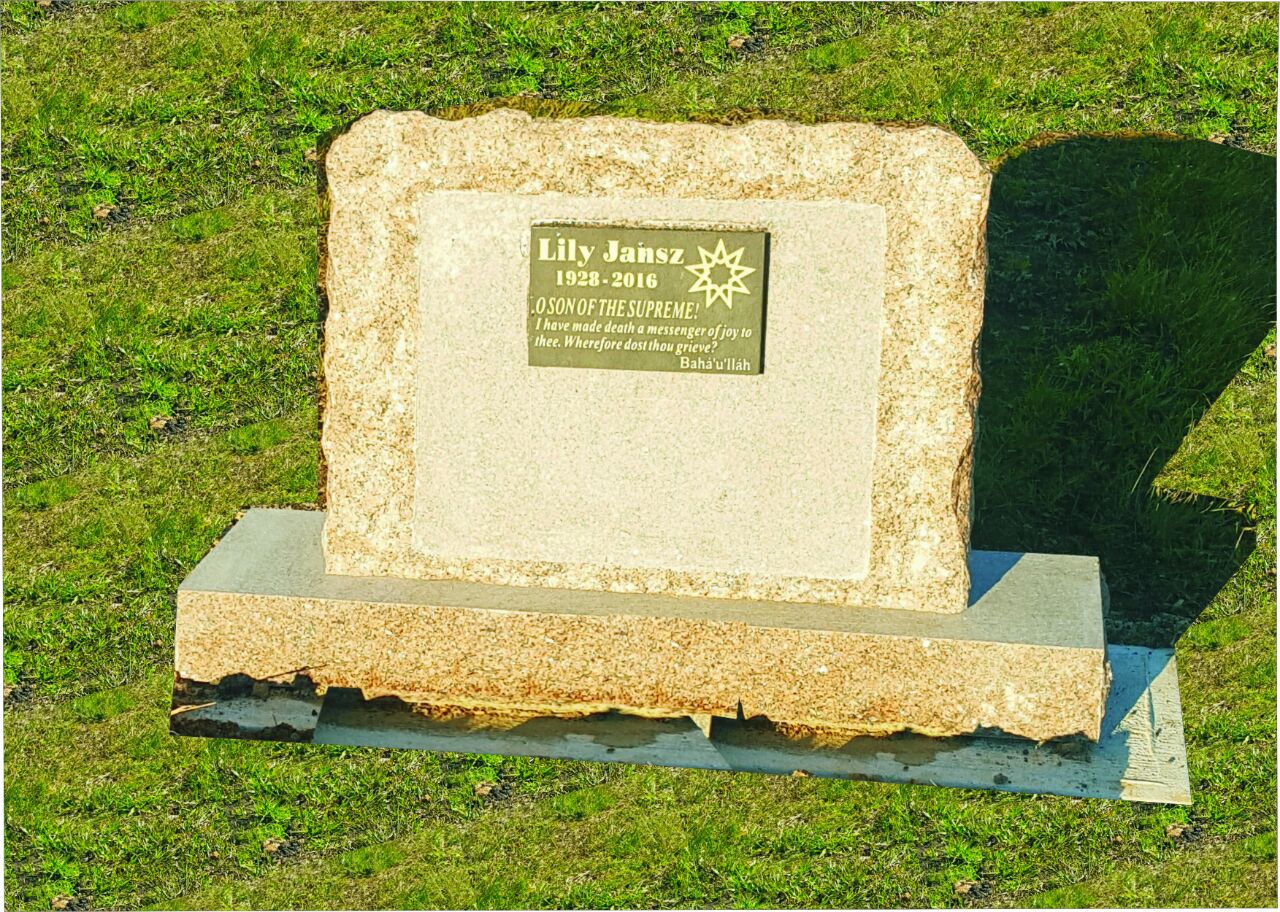
Resting Place of Lily Jansz, Narooma, New South Wales
Dr. John Bruha
Australia
6 January, 2017
Copyright©bahairecollections.com
NOTE: Dr. John Bruha passed away on 1 June 2020. May his soul rest in eternal peace in the Abha Kingdom
2 thoughts on “Lily Jansz and John Bruha – Pioneering Team”
Dear Dr. John,
What a moving account on how both of you teamed up perfectly to serve the Cause! I am more than confident the readers would certainly cherish these dramatic events that have well decorated the pioneering lives of both you and dear Lily Jansz, that have been well narrated.
Thank you so much for sharing your vivid story, it’s been an incredible time in your services. I do remember Lily Jantz well, having first met her in Penang in the early 1960s in Penang and subsequently in Cabramatta 20 years later, a devoted teacher, always happy to be in the field of service to friends and strangers alike.
Please share details of her resting place in Narooma as we would love to make a visit sometime.